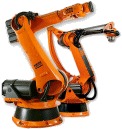
Photo from wikipedia
Underwater robot technology has made considerable progress in recent years. However, due to the harsh environment and noise in the flow field near the underwater robots, it is difficult to… Click to show full abstract
Underwater robot technology has made considerable progress in recent years. However, due to the harsh environment and noise in the flow field near the underwater robots, it is difficult to measure some basic parameters, including swimming speed. The traditional speed measurement methods for underwater robots have the disadvantages of being limited by the environment and bulky. In order to overcome these shortcomings, an artificial lateral line (ALL) sensor based on cantilever structure was developed in this paper. According to the deformation of cantilever beam under water impact, the swimming speed of underwater robots can be measured. In addition, an ‘end-to-end’ calibration algorithm was proposed to calibrate the ALL sensor in the noisy environment, avoiding the complicated noise modeling and filter design process. To reduce the risk of overfitting, a hybrid loss function based on physical model was adopted. Compared with the classical calibration method, our method can reduce the error by 47.8%. Our sensor achieved an average absolute error of 0.07897 m s−1, and can measure water speed up to 3 m s−1.
Journal Title: Smart Materials and Structures
Year Published: 2021
Link to full text (if available)
Share on Social Media: Sign Up to like & get
recommendations!